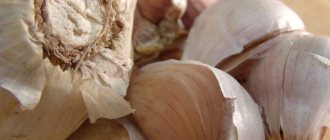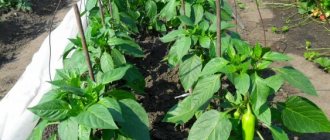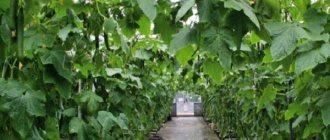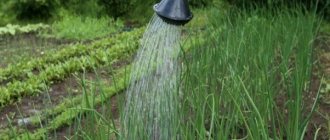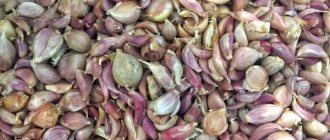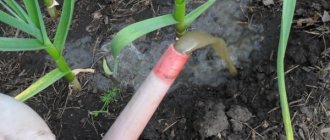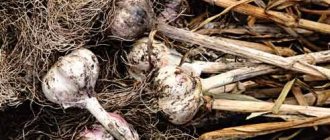Is it possible to plant garlic after garlic?
Garlic cannot be planted after garlic, as it is a monotonous crop:
- depletes the soil, drawing the same nutrients from it;
- allows pests and pathogens characteristic of it to accumulate in the soil.
In order for the soil to become suitable for garlic, you need to give it a break from garlic plantings for at least a year, and preferably two.
Although experienced gardeners say that it is best for spring varieties to skip five years and plant garlic in the same bed only in the sixth year, and for winter varieties to take a break of at least three years, four is better.
If you repeat planting every year, both the head and its constituent teeth will become smaller and smaller. Keeping quality and taste will deteriorate. A five-year break guarantees not only the restoration of the soil resource, but also the eradication of pests and pathogens of a given crop.
Basic principles and rules of crop rotation
Crop rotation rules:
- Botanical - closely related predecessors oppress the next generation due to the same need for microelements, identical diseases and pests, and similar toxins secreted by the rhizome.
- Temporary - the period of absence of closely related vegetables in one bed is 3-5 years.
- Fertile - planting plants that enrich the soil with oxygen and help replenish the vitamin and mineral complex.
Find out after which crops you can plant garlic in your garden.
Compliance with crop rotation allows you to solve the following problems:
- restore soil fertility;
- eliminate pests and fungal spores;
- increase productivity.
What to plant after garlic next year?
| Type of planting garlic | Culture |
| Spring | Tomatoes |
| cucumbers | |
| Potato | |
| Beet | |
| Peas | |
| Beans | |
| Strawberry | |
| Green manure crops | |
| Winter | lettuce |
| Spinach | |
| Dill | |
| Leaf lettuce | |
| Arugula | |
| Rye* | |
| Peas* | |
| Alfalfa, clover* | |
| Buckwheat* | |
| Sweet clover* | |
| White mustard* | |
| Rape* |
* - the crop is planted as green manure and mowed before flowering, leaving green mass on the bed.
Vegetable crop rotation table
Useful tips
Tips for summer residents on crop rotation:
- Study the botanical properties of plants. Pay attention to the substances that plants can secrete.
- Make a schematic drawing showing the arrangement of crops in the beds. Modify it every year and note how many years have passed since the change of location.
- For the winter, sow the entire area with winter green manures - wheat, rye, mustard.
Properly selected surroundings and compliance with crop rotation allow you to obtain a high yield of garlic and maintain soil fertility.
After what to plant garlic?
It is best to choose a predecessor crop for proper fruiting with long roots, so that the top layer of soil, depleted by a short root system, can rest and gain strength.
Before winter?
Winter barley will feel great in beds where green manure grains, with the exception of oats and barley, were harvested the day before. Good green manures are alfalfa and clover, soybeans, and other legumes: their powerful roots perfectly enrich the soil with nitrogen and loosen the densest clayey substances.
Good predecessors would be:
- strawberry;
- pumpkin (cucumbers, pumpkin, zucchini, squash, zucchini);
- cauliflower;
- cabbage of early varieties.
The following vegetables can be planted in front of garlic:
- medium cabbage;
- late varieties of cabbage;
- nightshades (sweet peppers, eggplants, tomatoes).
But when planting them, you need to remember that they also need nitrogen for nutrition.
In July
In general, the list of good and relatively good predecessors is the same for the spring crop and the winter crop. Spring garlic will grow well in place of nightshades (except tomatoes), legumes, after harvesting greens, and leafy salads.
In outskirts of Moscow
In the Moscow region and the central region of Russia, it is necessary to take into account the sowing time: due to the earlier onset of cold weather, garlic is planted for the winter not a month and a half before the first frost, but earlier.
Spring garlic is planted in early May, but not too late: late sowing will result in a decrease in yield.
According to gardeners near Moscow, garlic feels best after cucumbers, legumes, and strawberries. If you have melons (watermelons, melons) growing on your plot, you can sow garlic in this place.
Features of garlic in crop rotation
Garlic is a good repeller for insect pests, so it is often planted next to fruit trees and berry crops. But the plant greatly depletes the soil. If you do not replace it with an analogue that enriches the soil with microelements, the stem nematode will settle in it. The root system of bulbous plants releases mycotoxins during the entire life cycle, which remain in the soil and then poison the plant itself and nearby crops.
Important! With intensive cultivation of garlic, the degree of infection with garlic nematode reaches 57%. If crop rotation rules are not followed, the nematode affects all plants on the site. There are frequent cases of complete destruction of the crop.
Bulbous plants secrete phytoncides that remain in the soil for a long time. This feature can be used to advantage for other crops by selecting those that need antibacterial treatment.
Why should you not plant garlic?
It is strictly forbidden to plant garlic after garlic and all types of onions. Alliums pull potassium from the soil. Precursors such as root vegetables - potatoes, beets and carrots - have a bad effect on garlic. Carrots generally require the soil to rest after itself, since it is a very “gluttonous” crop. And potatoes and beets can leave behind fusarium, which safely affects garlic crops. Bad effects on garlic:
- radish;
- turnip;
- mint;
- celery;
- leaf lettuce.
Good harvest plants
There are many crops that are best planted in areas where garlic previously grew. What to plant after harvesting garlic? In the vacated garden bed you can grow strawberries, cucumbers, any legumes, annual herbs, and winter wheat.
If you alternate garlic with cucumbers, the yield of both crops increases. What to sow after garlic? An excellent option are umbelliferous crops such as dill. After planting garlic, as well as next to it, strawberries grow well in this garden plot.
To prevent the garlic bed from being empty in the winter after harvesting, it is sown with wheat or other plants that will also serve as good green manure. For this purpose, rye, mustard, phacelia, vetch and others are often used. The earth will rest, and the plants will replenish its supply with useful substances.
Best neighbors, what to plant next to garlic?
Garlic is good because the phytoncides and etherols it contains inhibit the development of fungal spores, so fungal diseases do not occur in those beds where garlic grows. In addition, this crop is an excellent fungicide and insecticide; harmful insects are also afraid of it. And this should be used when forming beds with crops.
Although carrots and garlic are bad predecessors for each other, if they are planted at the same time, they get along well and even help each other: for example, carrot pests such as the psyllid and carrot fly do not tolerate garlic phytoncides.
All nightshades - tomatoes, peppers, eggplants - grow better and are less damaged with such a neighbor as garlic. And if you plant potato beds around the perimeter with garlic, the Colorado potato beetle will bypass them.
Garlic also has a very good effect on strawberries, repelling pests from the berries. And not only strawberries respond well to such a neighborhood: raspberry and currant bushes will not be “populated” by aphids, ants and bugs: the garlic aroma is completely unacceptable for them.
Best follower
Various crops can be planted in place of garlic
What can you plant after garlic? It is necessary to take into account what kind of garlic grew in the garden last year. If we are talking about winter varieties, then planting cucumbers after them will be optimal, because winter garlic actively saturates the soil with nitrogen. For spring varieties, it will be useful to fertilize the soil in advance with potassium and phosphorus fertilizers. The basic rule when planting in this case is that it is necessary to plant only those garden crops that prefer the substances accumulated a year earlier by another crop. There are crops that are best suited for planting in garlic soil exactly the next year.
cucumbers
An excellent harvest of cucumbers is obtained precisely in garlic beds - the nitrogen-filled soil perfectly nourishes the cucumber shoots, which directly affects the number of fruits harvested. Cucumbers should be planted keeping a distance of 30-50 cm between plantings.
Potato
Early potatoes also feel good in the garden after the bulbous ones, they recover from the substances left a year earlier, but such a turn will only harm mid-season and late potato varieties, since the tubers can become infected with dangerous fusarium. Thinning strips in potatoes are an excellent protection for the latter from the annoying Colorado potato beetle. By the time the shoots form in July, the plant is actively preparing for self-defense from gray rot; at this time, between plantings, you can sow dill on the greens.
Beds in which plants are planted in a checkerboard pattern look beautiful and decorative - this way they are not only in proper cooperation with each other, but also refresh the overall appearance of the garden. Plant potatoes in meter by meter squares, and fill the space between them with other plantings. Each season, simply move suitable plants to the adjacent free square.
Strawberry
Perhaps the best choice for the neighborhood next year will be strawberries, beloved by gardeners. During growth, bulbs release useful substances - phytoncides, which remain in the soil in the second year. Phytoncides have the best effect on the root system of berries, killing pathogenic bacteria and fungi. By planting strawberries, gardeners not only save the latter from common pests, but also spur the development of other plants adjacent to the garden bed and next to it, provoking their development and active growth. Some gardeners grow strawberries and garlic together.
A better option may be to grow bulbous plants around the perimeter of the bed, with strawberries as the main plant. In this way, the plantings will influence each other as positively as possible and visually will not take up much space.
Tomatoes
We haven’t yet come up with a better way to prevent aphids from appearing in the garden. After planting garlic, you need to sow this bed with tomatoes or plant tomatoes between rows of cucumbers, beets and radishes. This neighborhood is in perfect harmony with each other. In this case, there is also a special symbiosis - the bulbous plants previously growing in the garden bed, thanks to their smell, will scare off not only the voracious horde of aphids, but also the mole cricket and the May beetle, which are capable of completely destroying all the plantings in just a few hours. In turn, nightshade crops will protect other plants from dangerous scab. Only in this case you need to maintain a distance when landing. So that plants do not interfere with each other’s growth, but complement and help, it is necessary to plant plants at a distance of at least 30-50 cm from each other.
Carrot
The next year after planting the bulbous plants, you can plant carrots in this bed. Also, experienced gardeners believe that growing these two crops together only benefits both. Garlic protects carrots from the carrot fly, which eats the upper part of the plant, preventing the rhizome from fully developing. After removing the shoots, the carrots begin to secrete a special substance that significantly increases the weight and size of the garlic head. Therefore, it is better to plant such crops together or in adjacent beds, where the distance between plantings is no more than 65 cm.
Often the beds are sown with flowers and grass
Flowers
Some types of flowers are especially favorable to their bulbous neighbors. Next to it, asters, roses and gladioli will be protected from the fungus that often affects them.
Horseradish
By planting a bulbous plant next to horseradish or after it in the second year, you can significantly increase the concentration of ascorbic acid in the above-ground, green part. For example, if you plant horseradish and radish after garlic, then a pungent and specific smell will remain in such a bed for a long time, but the soil will be disinfected and rich in microelements that are well suited for legumes. But after such caustic plantings, it is not recommended to plant delicate crops, such as fruits, in this bed.
Roots
For root vegetables and lovers of short daylight hours, the bed after the garlic will be a fairly good place:
- We are used to growing radishes in the spring, at the beginning of summer, but he will also really like the end of the summer season. It will be even tastier and juicier.
- Daikon planted in autumn will never shoot. And 12-14 hours of daylight is ideal for him to grow well.
- Green, or Margelan, radish and black radish of late varieties are specially planted during this period to improve the quality of winter storage.
Greenery
Everyone loves summer for the delicious and fortified greens on the table. Almost every green crop, such as dill, lettuce, cilantro, parsley, spinach, will have time to grow after garlic. In addition, at this time, most of the pests that attack these plants are already harmless. The only advice is to water them more often and cover them from the scorching sun with non-woven covering material.
Greenery. The illustration for the article is used under the standard license ©ofazende.com
On a note
Garlic is returned to its original place no earlier than after 6–7 years. This rule is strictly observed, because there is a high risk of increased proliferation of pests and a small harvest. In a former garlic bed, cabbage does not do well enough, although with proper care it is possible to achieve yields.
Of course, a table showing what can be planted next year in open ground after garlic is not a panacea. Despite observing crop rotation, it is important to strictly follow the agronomic rules necessary for the growth of crops. But, caring for the soil will allow you to reduce the required amount of fertilizing, while achieving the most abundant harvests. Using the accumulated knowledge and introducing it into practice, you can significantly reduce labor costs and increase the efficiency of your own labor.
Author: Maria
Source: mainavi.ru
after garlic, what to plant, what to plant
Forbidden vegetables
There are plants that it is better not to plant after sprouting garlic. Naturally, they will develop, but the yield level will be significantly lower than expected. It is not recommended to plant the following plants and crops after garlic:
- Cabbage. It will grow, but the fruit will not be what the gardener wants.
- Beans and peas will also not feel very comfortable near such a neighbor. If there is enough space to plant these legumes, then it is better to do it separately.
- Onions and garlic should not be replanted either.
Experts assure that there are no special prohibitions regarding the neighborhood, but vegetables should benefit each other in the development process. Many gardeners do not use drugs that are aimed at destroying diseases and harmful insects. All this is thanks to the correct measures during the planting period. The yield level is excellent. It is recommended that special efforts be made by those individuals who have a small plot of land and have to carry out planting closely.
